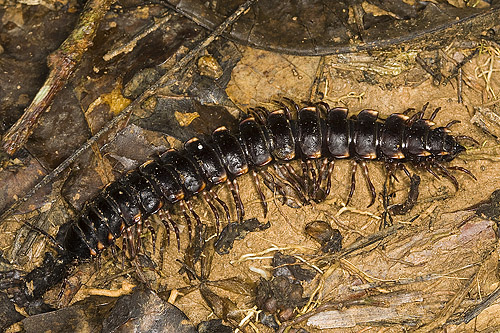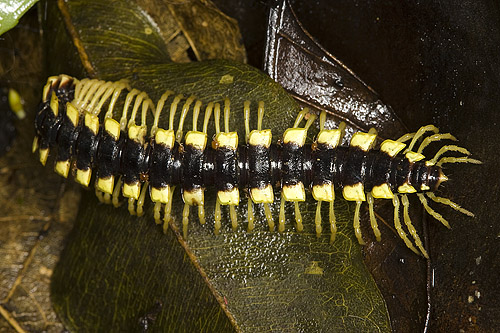
Myriapoda
Diplopoda
Millipedes
The millipedes are differentiated from other Myriapods by having 2 pairs of legs per body segment. They have the most legs of any animal, but never actually get close to the 1000 legs their name suggests. Even the leggiest species (Illacme plenipes from California, USA) "only" has 750 legs. Most species are slow-moving, detritus feeders. They are generally harmless, but a few species are capable of squirting a caustic liquid as a defense mechanism. This can be particularly painful if it gets into the eyes and may, in some cases, cause blindness.

Cyanide Millipede (Harpaphe haydeniana)
Vancouver Island, Canada - September 2011

Pill Millipede (Glomeris marginata) - Anglesey, Wales - March 2009
If threatened, pill millipedes will roll into a tightly-sealed ball.

Pill Millipede (Glomeris marginata) - Anglesey, Wales - March 2009
Once the danger is perceived to have passed, the millipede slowly unrolls...

Pill Millipede (Glomeris marginata) - Anglesey, Wales - March 2009
Like most millipedes, the pill millipede is capable of secreting noxious chemicals as a defense against predators. This ant rapidly lost interest in its investigation, allowing the millipede to continue its slow trundle across the sand unmolested.

Pill Millipede (Glomeris marginata) being investigated by a Black Ant (Lasius niger) - Anglesey, Wales - March 2009
In the tropics, some millipedes grow quite large. The individual below was about 10cm long, but this is still quite small compared to some of the African species which can exceed 30cm in length...over a foot long!

Manu, Peru - December 2009

Tambopata, Peru - December 2009
The two species above and below are representatives of "flat-backed" millipedes. The more 2-dimensional shape of these millipedes allows them to more easily penetrate the leaf litter and narrow crevices. The species below was approximately 15cm in length.

Tambopata, Peru - December 2009
Ray Wilson owns the copyright of all images on this site.
They may not be used or copied in any form without prior written permission.
raywilsonphotography@googlemail.com